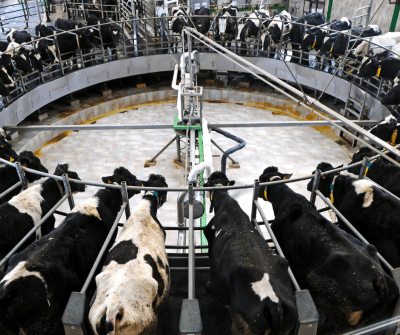Dairy product prices have strengthened during March and have been higher all month than averages for February, says Bob Cropp, University of Wisconsin Extension dairy economist.
 On the CME, 40-pound cheddar blocks averaged $1.58 per pound for February, started March at $1.62 and reached the high of $1.80 later in March. Cheddar barrels averaged $1.44 per pound in February, started March at $1.42, reached a high of $1.55 but have fallen back to $1.49. Dry whey averaged 54 cents per pound in February, started March at 55 cents per pound and then reached the high of 61 cents. Dry whey has strengthened steadily since September when it was around 33 cents per pound. This strength had added nearly $1.60 to the Class III price.
On the CME, 40-pound cheddar blocks averaged $1.58 per pound for February, started March at $1.62 and reached the high of $1.80 later in March. Cheddar barrels averaged $1.44 per pound in February, started March at $1.42, reached a high of $1.55 but have fallen back to $1.49. Dry whey averaged 54 cents per pound in February, started March at 55 cents per pound and then reached the high of 61 cents. Dry whey has strengthened steadily since September when it was around 33 cents per pound. This strength had added nearly $1.60 to the Class III price.
“With these improvements in dairy product prices, the March Class III price will be near $16.30 compared to $15.75 for February,” Cropp says.
CME butter prices showed strength in March. Butter averaged $1.38 per pound in February, started March at $1.63 and later went to $1.71. Nonfat dry milk averaged $1.11 per pound in February, started March at $1.14, reached a high of 1.17 and then went to $1.16.
“With these improvements in prices, the March Class IV price will be near $14.35 compared to $13.19 in February,” he adds.
“Milk prices for the remainder of the year are uncertain,” Cropp says, “but there are positive signs.”
Restaurants in some states are being allowed to expand indoor dining and some schools are allowing the partial return of students. “This is already showing improvement in food service sales, which is positive for butter and cheese prices,” he explains. “Hopefully, by fall restaurants and schools will be operating more normally.”
Dairy exports are expected to stay relatively strong for nonfat dry milk and skim milk powder, with exports higher than a year ago for butter and whey products, according to Cropp. Butter, cheese, and nonfat dry milk and skim milk powder prices are very competitive to other major dairy exporters.
Port congestions, container shortages and labor shortages stemming from trade imbalances created by the pandemic undercut dairy exports last year. This is expected to improve in 2021.
On the downside, stock levels are relatively high and need to be worked down. The latest stock report showed Jan. 31 stocks of butter up 33% from a year ago, American cheese stocks 3% higher, total cheese stocks also 3% higher, nonfat dry milk stocks 8.8% higher and dry whey stocks 7.1% higher. Expected improved domestic sales and dairy exports will help draw down stocks, Cropp believes.
“Milk production for the remainder of the year will be a major factor affecting the level of milk prices,” he says. “USDA revised January milk production to be 2.4% higher than a year ago. February milk production adjusting for 29 days in February a year ago showed milk production was 2% higher.”
Milk cow numbers started to increase month-to-month in July last year. February cow numbers increased another 3,000 to 81,000 more than a year ago, or 0.9% higher. Adjusting for 29 days in February, a year ago milk per cow is 1.2% higher.
“Thus, milk production continues at a relatively higher level, putting downward pressure on milk prices. Nine of the 24 selected states had less February milk production than a year ago, and 10 had fewer milk cows,” Cropp says. “Favorable milk prices will require improved domestic sales and strong exports.”
Current Class III dairy futures have recently weakened some but are still fairly optimistic. Class III futures reached the low $18s by June and stayed in the low 18s through November before falling to the $17s in December.
Protect prices
“These prices provide some opportunity for dairy farmers to protect more favorable milk prices with Class III futures or options or using the Dairy Revenue Protection program,” he says. “With feed prices higher than a year ago, protecting milk prices is important.”
USDA is not as optimistic about milk prices. Its latest forecast has Class III milk averaging just $16.75 for the year compared to $18.16 last year. The level of government purchases of cheese, butter and fluid milk is not likely to be at the level of last year to support milk prices. The fifth round of the Farms to Families Food Box program expires in April. There remain other government programs where dairy products will be purchased for school lunches and food banks.
“Price forecasts will no doubt change as the level of milk production, domestic sales and dairy exports unfold,” Cropp says.
Source: Wisconsin Agriculturist




